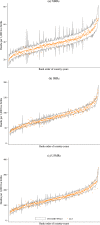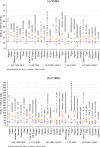Age distribution, trends, and forecasts of under-5 mortality in 31 sub-Saharan African countries: A modeling study
- PMID: 30861006
- PMCID: PMC6413894
- DOI: 10.1371/journal.pmed.1002757
Age distribution, trends, and forecasts of under-5 mortality in 31 sub-Saharan African countries: A modeling study
Abstract
Background: Despite the sharp decline in global under-5 deaths since 1990, uneven progress has been achieved across and within countries. In sub-Saharan Africa (SSA), the Millennium Development Goals (MDGs) for child mortality were met only by a few countries. Valid concerns exist as to whether the region would meet new Sustainable Development Goals (SDGs) for under-5 mortality. We therefore examine further sources of variation by assessing age patterns, trends, and forecasts of mortality rates.
Methods and findings: Data came from 106 nationally representative Demographic and Health Surveys (DHSs) with full birth histories from 31 SSA countries from 1990 to 2017 (a total of 524 country-years of data). We assessed the distribution of age at death through the following new demographic analyses. First, we used a direct method and full birth histories to estimate under-5 mortality rates (U5MRs) on a monthly basis. Second, we smoothed raw estimates of death rates by age and time by using a two-dimensional P-Spline approach. Third, a variant of the Lee-Carter (LC) model, designed for populations with limited data, was used to fit and forecast age profiles of mortality. We used mortality estimates from the United Nations Inter-agency Group for Child Mortality Estimation (UN IGME) to adjust, validate, and minimize the risk of bias in survival, truncation, and recall in mortality estimation. Our mortality model revealed substantive declines of death rates at every age in most countries but with notable differences in the age patterns over time. U5MRs declined from 3.3% (annual rate of reduction [ARR] 0.1%) in Lesotho to 76.4% (ARR 5.2%) in Malawi, and the pace of decline was faster on average (ARR 3.2%) than that observed for infant (IMRs) (ARR 2.7%) and neonatal (NMRs) (ARR 2.0%) mortality rates. We predict that 5 countries (Kenya, Rwanda, Senegal, Tanzania, and Uganda) are on track to achieve the under-5 sustainable development target by 2030 (25 deaths per 1,000 live births), but only Rwanda and Tanzania would meet both the neonatal (12 deaths per 1,000 live births) and under-5 targets simultaneously. Our predicted NMRs and U5MRs were in line with those estimated by the UN IGME by 2030 and 2050 (they overlapped in 27/31 countries for NMRs and 22 for U5MRs) and by the Institute for Health Metrics and Evaluation (IHME) by 2030 (26/31 and 23/31, respectively). This study has a number of limitations, including poor data quality issues that reflected bias in the report of births and deaths, preventing reliable estimates and predictions from a few countries.
Conclusions: To our knowledge, this study is the first to combine full birth histories and mortality estimates from external reliable sources to model age patterns of under-5 mortality across time in SSA. We demonstrate that countries with a rapid pace of mortality reduction (ARR ≥ 3.2%) across ages would be more likely to achieve the SDG mortality targets. However, the lower pace of neonatal mortality reduction would prevent most countries from achieving those targets: 2 countries would reach them by 2030, 13 between 2030 and 2050, and 13 after 2050.
Conflict of interest statement
The authors have declared that no competing interests exist.
Figures



References
-
- Hill K, You D, Inoue M, Oestergaard MZ, Technical Advisory Group of the United Nations Inter-agency Group for Child Mortality Estimation. Child Mortality Estimation: Accelerated Progress in Reducing Global Child Mortality, 1990–2010. Byass P, editor. PLoS Med. 2012. August 28;9(8):e1001303 10.1371/journal.pmed.1001303 - DOI - PMC - PubMed
-
- UN. Transforming our world: the 2030 Agenda for Sustainable Development. United Nations General Assembly; October 2015.
-
- Alkema L, New JR. Global estimation of child mortality using a Bayesian B-spline Bias-reduction model. Ann Appl Stat. 2014. December;8(4):2122–49.
-
- UN IGME. Levels & Trends in Child Mortality: Report 2018, Estimates Developed by the UN Inter-agency Group for Child Mortality Estimation. United Nations Children’s Fund, New York; 2018.
-
- UN. World Population Prospects: The 2017 Revision. United Nations, Department of Economic and Social Affairs, Population Division; 2017.
Publication types
MeSH terms
Grants and funding
LinkOut - more resources
Full Text Sources
Research Materials
Miscellaneous

